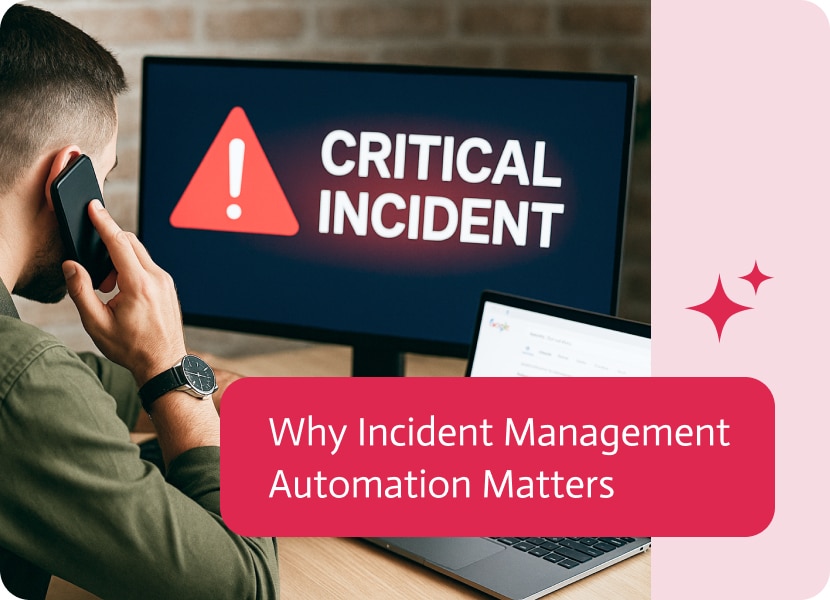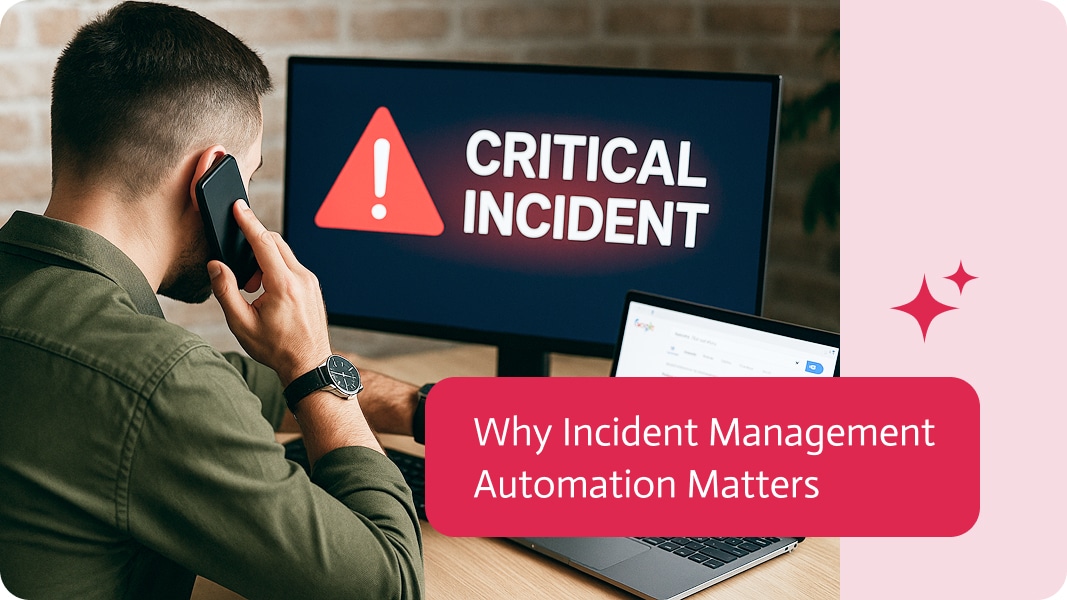

Why Incident Management Automation Matters
The use of software and systems to automatically identify, address, and resolve IT incidents, such as system failures, performance deteriorations, or security breaches without (or with very little) human intervention, is known as incident management automation.
Assume that the time is 2:04 AM. Halfway around the world, your app crashed completely. The database is not responding, customers are getting errors, and your pager is about to die.
The catch is that before the alert even reaches your phone, a silent army of monitors, workflows, and scripts is already in operation. A known fix from your runbook is working automatically, a server is restarting, and logs are being parsed. Your app is back online without anyone noticing.
Greetings from the realm of incident management automation, where operational nightmares collide.
What Exactly Is Incident Management Automation?
Essentially, it’s a set of tools designed to accomplish the following:
- Detect issues quickly,
- Decide how serious they are,
- Notify the right people (if needed),
- And ideally, fix the problem without human hands getting dirty.
This isn’t just about shrugging off work (though not being woken up at 2 AM is a nice perk). It’s about speed, consistency, and scale.
The Old Way: Painfully Manual
Let’s take a quick tour down memory lane. In the “classic” setup, here’s what happened during an incident:
- A customer calls to say something’s broken.
- Someone checks logs manually.
- They realize a service crashed.
- They restart it and hope for the best.
- Hours later, someone writes a post-mortem—usually after more coffee than sleep.
This method relies on tribal knowledge, a bunch of lucky guesses, and someone being available at just the right time. Not ideal, especially when your business depends on uptime.
The New Way: Smart, Fast, Automated
Modern incident management has shed its pager-era skin. Today, it’s less about frantic Slack messages and more about well-orchestrated digital choreography. The whole process, from the moment something goes wrong to the second it’s resolved. It’s been redesigned for efficiency and flexibility.
First Line of Defense: Monitoring Systems That Never Blink
Gone are the days of waiting for a customer complaint to find out your site is down. Today’s tech stacks are wired into a nervous system of real-time monitoring. Think Datadog, Prometheus, New Relic, and Grafana. These systems are always watching, constantly sniffing for signs of trouble like:
- A sudden spike in error rates
- Creeping CPU or memory usage
- A traffic surge from a suspicious IP block
- Slower-than-usual response times
- Queues backing up in your messaging systems
These aren’t passive tools—they’re set up with thresholds, anomaly detection, and predictive alerts. That means if your app’s login failures jump by 300% in 10 minutes, the system knows it’s not just a fluke and kicks off the next phase.
When Trouble Brews, Alerts Don’t Just Yell—They Do
Once the monitoring system spots something amiss, it doesn’t just fire off an email and call it a day. Instead, it alerts smart escalation and response tools such as PagerDuty, Opsgenie, VictorOps, or xMatters.
They’re basically like mission control. But here’s the cool part: the alert doesn’t just show up on your dashboard and ruin someone’s lunch break. It triggers action.
- If a Kubernetes pod crashes, a script automatically restarts it.
- If database latency crosses a threshold, an extra read replica spins up.
- If a specific error code hits more than 50 requests per minute, traffic reroutes or gets throttled.
- If an IP is committing far too many requests too fast, a firewall rule blocks it in real-time.
In other words, your system isn’t waiting for a human to respond—it’s already trying to fix the problem.
Automation of Workflow: The Real MVP
The magic is actually what happens behind the scenes: automated workflows.
Think of these as battle-tested recipes for the most common problems. They’re predefined, well-documented, and machine-triggered. The moment something breaks, the system follows a playbook without waiting for approval.
For example:
- A memory leak causes a service to exceed usage limits → The system runs a diagnostic, restarts the service, and posts a summary to Slack.
- A spike in HTTP 500s triggers a rollback of the latest deployment → Traffic is shifted to the previous version automatically.
- Disk usage on a production VM hits 90% → The system cleans up log files, archives old data, and sends a quick report to the infra team.
All this happens within seconds.
No one’s fumbling through Wikis at 3 AM. No one’s frantically typing SSH commands on a tiny phone screen. The system executes the fix calmly, efficiently, and exactly the way you programmed it.
And If That Doesn’t Work? Instant Escalation
Not every issue can be resolved by automation—and that’s okay.
If the first round of automated fixes don’t work, the system escalates automatically to a human, but with context. You’re not just getting an alert that says, “Something broke.” You get:
- What failed
- What the system already tried
- Logs or metrics from the event
- Suggested next steps (based on past incidents)
This means your engineers hit the ground running. No hunting for logs, no guessing games. Just straight to the real work.
And the escalation rules? Totally customizable. You can route based on severity, team, time of day, or even the type of issue (network vs application vs infrastructure).
Smart Enough to Learn, Structured Enough to Scale
Today’s incident response tools incorporate features that allow them to learn over time, rather than simply reacting to pre-defined triggers. Most of them utilize machine learning for recurring problem issue detection, altering runbooks for automation, and even predicting possible at-risk components. These response systems are capable of silencing flappy alerts that lead to “alert fatigue”—one of the most counterproductive issues an operational team suffers from.
Automation becomes powerful at this point in time, you aren’t just coding responses but are instead engineering a nervous system that withstands shocks resulting from almost every tech stack.
No matter how complex the infrastructure becomes, be it microservices, complex monolithic structures, or serverless functions, this system adapts to your needs and scales accordingly. More servers? Services? You got it. Automation doesn’t bat an eye.
No longer is incident management merely reactive, it’s evolved into proactive, even anticipatory. Monitoring solves issues prior to them becoming far larger headaches, alerting systems step beyond shouting, and acting upon their commands. Automated workflows solve problems at machine speed. When situations start to spiral out of control, things get escalated quickly, with full context, and in an orderly manner.
This is not a case of technology replacing a human workforce. The idea is enabling humans to tackle difficult problems while systems handle dynamic chaos with exemplary efficiency.
In scenarios where each second truly counts, it is critical to have a state of system ready to respond immediately without wasting time analyzing the situation.
What Makes It Tick: The Tech Behind the Magic
The best incident management systems have a broad range of features that include monitoring, detecting, alerting, and routing.
Incident detection, alert generation, and message routing are the three fundamental building blocks of incident management systems. It’s a machine that works unceasingly and seamlessly while having complete awareness of everything going on around it. This ensures that any problems are addressed before they worsen.
The backbone of every system is monitoring and detection, and the data retrieval at the starting point is vitally important. It is impossible to repair something when you are not aware that it is damaged; for this reason, Datadog, Prometheus, and CloudWatch, as well as other similar services, are invaluable. In addition to determining error rates, memory usage surges, and services sluggishly declining without a tangible cause, these platforms are always ready to utilize sentry services for metrics gathering, log parsing, and problem sensing. All tripwires are installed to act as external triggers that signal the need for an alarm.
After ensuring the above conditions and transforming them into broad-ranging reports with built-in relational database systems ready to mobilize whenever the troop request lines are busy, one can move on to follow-up actions. The subsequent part of the puzzle that comes after being noticed is ignoring the alerts. Step into the limelight: this is where tools like PagerDuty, Opsgenie, and even less popular VictorOps shine. Everyone agrees that these are far more than simple pingers; rather, they are sophisticated alerting systems geared to determine not only who is on call, but exactly when escalation is warranted, who drowns everyone with notifications that skirt the threshold of pulsing annoyance and duplicate spam, or subordinate to low priority pings plunging into the void. It results in streamlined information flow by getting precisely the right data to the right person (or bot) in the shortest time possible.
But here’s the point where it gets really fascinating: automated response. These systems can be configured to take action as soon as something breaks, so no human typing out a fix is required. They can automatically restart a crashed service, roll back a buggy deployment, increase available resources during traffic spikes, check for problems, or even execute a pre-set script from your incident playbook. People refer to this type of automation as ‘self-healing infrastructure.’ Such systems are so efficient that they solve countless problems long before anyone has to look at their phone.
The most critical tools running deeper within these systems are runbooks and frameworks: the quiet workhorses of the operation. These checklists describe every detail of the system’s response. Instead of relying on the tribal knowledge or a usable memory, you document a fix. “If X service fails, run script Y,” or “If error rate goes above 10 percent and stays there for more than five minutes, restart service Z and send the report.” Tools like StackStorm, xMatters, and even those built into the cloud, such as AWS Systems Manager, seamlessly meld these playbooks into your infrastructure.
As a whole, this technology stack builds a proactive and automated safety solution, a safety net to maintain system operation and protect your team from burnout even when the pressure is at its highest.
What Can Be Automated?
You’d be surprised. Here are just a few examples:
| Incident Type | Automated Response |
| Web server crashes | Restart service via systemd or Kubernetes |
| High CPU usage | Auto-scale resources or throttle traffic |
| Failed deployments | Roll back to previous working build |
| Suspicious login detected | Block IP and trigger a security audit workflow |
| Full disk warning | Clean up temp files and notify system admin |
Real-World Example: A 2-Minute Recovery
Let’s say your API gateway crashes at 3:17 AM due to a sudden surge in traffic.
- Datadog detects a spike in 502 errors.
- Alert goes to PagerDuty, which sees this has happened before.
- A pre-configured runbook kicks in: scales out more instances and reroutes traffic.
- Load normalizes, errors drop, issue resolved.
- PagerDuty still drops a note into Slack with the incident report for transparency.
From failure to recovery in two minutes flat. You? Still sleeping like a baby.
The Benefits Go Beyond Speed
Honestly, faster is great, but here’s what else you gain:
- Reliability: Automated responses are consistent. They don’t forget a step. They don’t panic. They just do what they’re told.
- Scale: As your business grows, so do your systems. Manual response doesn’t scale. Automation does.
- Burnout Protection: Engineers are human. They need sleep, breaks, and sanity. Incident automation cuts down on middle-of-the-night fire drills, making on-call duty less dreadful.
- Postmortem Gold: Most tools keep logs of every action taken. So after the smoke clears, you get a detailed timeline of what happened and why. That’s priceless for learning and improving.
The First Steps: The Initial Actions
It’s not necessary to automate everything in one go. Here’s a quick look:
- Assess your incidents to see which ones occur frequently. Which ones have the same pattern of fixes?
- Start with repeatable solutions when fixing documents. Make runbooks or scripts out of them.
- Select your equipment. You probably already have monitoring. Add basic response and alerting now.
- Automate a small test, such as restarting a service. Track the outcomes.
- As your confidence increases, gradually add more automation.
Wrapping It Up
Traditional incident handling—manual alerts, scattered logs, and late-night heroics—is slow and error-prone. Modern infrastructure needs a faster, smarter response.
Noca AI changes the game. Real-time monitoring, intelligent alerting, automated workflows, and runbooks are all built in. With prompt-to-flow, plain-language instructions turn into actionable workflows, making complex incident responses easy to design and deploy. AI-driven diagnostics continuously learn, helping your team move from firefighting to future-proofing.
Noca AI keeps teams sane, systems stable, and downtime a thing of the past.


